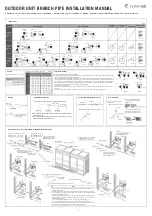
18
Unit Start-Up
IMPORTANT
Units should be energized 24 hours before unit startup
to prevent compressor damage as a result of slugging.
1.
Inspect all factory- and field-installed wiring for loose
connections.
2. Verify that the manifold gauge set is connected.
3. Add additional refrigerant charge if required before
opening valves and while system is still under a
vacuum.
4.
Open the liquid and suction line service valves to
release the refrigerant charge contained in outdoor
unit into the system.
5. Replace the stem caps and tighten to the value listed
in “Table 1. Torque Requirements” on page 7.
6. Check voltage supply at the outdoor unit terminal strip.
The voltage must be within the range listed on the
unit’s nameplate. If not, do not start the equipment
until you have consulted with the power company and
the voltage condition has been corrected.
7. Refer to the included user guide to operate the system
using the provided remote control.
8. Visually check for binding of both indoor and outdoor
fans.
Troubleshooting
Table 8. Indoor Unit Error Codes
Display Error Information
E0
Indoor unit EEPROM parameter error
E1
Indoor / outdoor units communication error
E2
Zero-crossing signal detection error
E3
The indoor fan speed is operating outside of the normal
range
E4
Indoor room temperature sensor T1 is in open circuit or
has short circuited
E5
Evaporator coil temperature sensor T2 is in open circuit or
has short circuited
EC
Refrigerant leak detected
F0
Overload current protection
F1
Outdoor ambient temperature sensor T4 open circuit or
short circuit
F2
Condenser coil temperature sensor T3 is in open circuit or
has short circuited
F3
Compressor discharge temperature sensor TP open circuit
or short circuit
F4
Outdoor unit EEPROM parameter error
F5
The outdoor fan speed is operating outside of the normal
range
p0
IPM malfunction or IGBT over-strong current protection
p1
Over voltage or over low voltage protection
p2
High temperature protection of IPM module
P3
Outdoor ambient temperature too low.
Table 8. Indoor Unit Error Codes
Display Error Information
p4
Inverter compressor drive error
Test Run
Pre-Checks
Only perform test run after you have completed the
following steps:
•
Electrical Safety Checks – Confirm that the unit’s
electrical system is safe and operating properly.
•
Refrigerant Leak Checks – Check all flare nut connec
tions and confirm that the system is not leaking.
•
Confirm that suction and liquid valves are fully open.
Procedure
You should perform the Test Run for at least 30 minutes.
1. Connect power to the unit.
2.
Press the ON/OFF button on the remote controller to
turn it on.
3. Let each function run for 5 minutes, and perform the
following checks:
Test Run Checklist
Table 9. Test Run Checklist
Checks
Pass
Fail
No electrical leakage
Unit is properly grounded
All electrical terminals properly
covered
Indoor and outdoor units are solidly
installed
All pipe connection points do not leak
Water drains properly from drain hose
All piping is properly insulated
Unit performs COOL function properly
Indoor unit louvers rotate properly
Indoor unit responds to wireless
remote
Double-Check Line Set Connections
During operation, the pressure of the refrigerant circuit
will increase. This may reveal leaks that were not present
during your initial leak check. Take time during the Test
Run to doublecheck refrigerant line set connections and
verify there are no leaks.
1. Using the wireless remote control, return unit to the
normal operating temperature.
2. Using insulation tape, wrap the indoor refrigerant pipe
connections that you left uncovered during the indoor
unit installation process.
Содержание MCA Series
Страница 20: ...20 ...



































